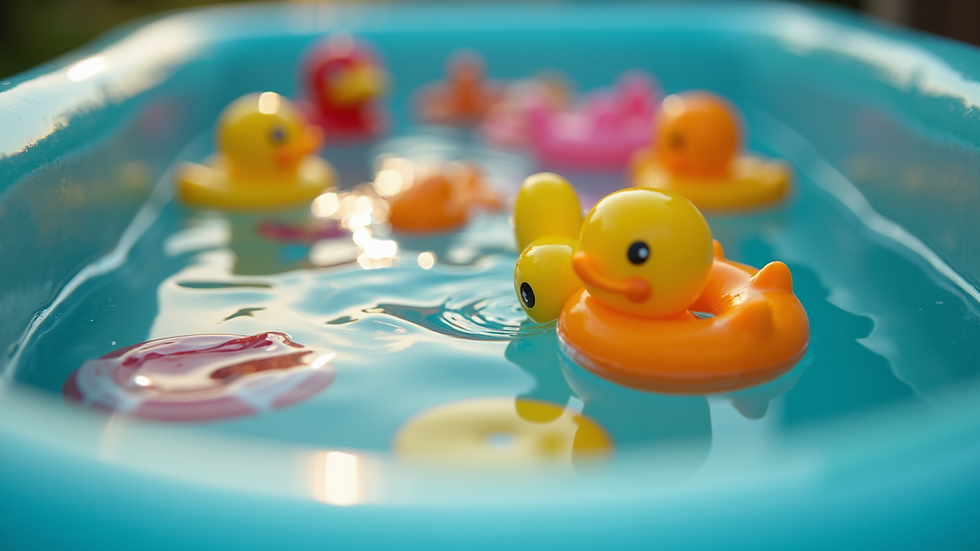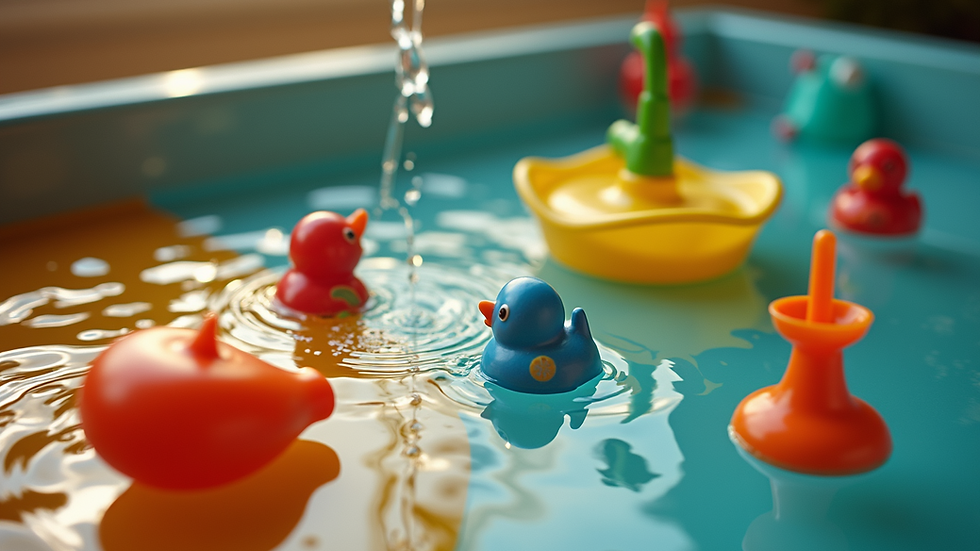Dive into Safe Water Play: The Ultimate Parent’s Guide to Joyful and Secure Sensory Adventures!
- Teresa G.
- Jul 9
- 5 min read
Water play can be a thrilling adventure for sensory-seeking children. It offers not only fantastic sensory stimulation but also helps them develop crucial skills, boost creativity, and promote physical growth. Most importantly, prioritizing safety is essential to ensure fun and enjoyment. In this guide, we will explore how to navigate the joyful world of water play while keeping your children secure and safe.
Understanding Sensory-Seeking Behavior
Sensory-seeking children crave stimulation to explore and interact with their surroundings. Water play combines tactile, visual, and auditory experiences that appeal to these children. For instance, they may delight in splashing, pouring, and feeling different water textures.
By understanding your child's behaviors and needs, you can create a supportive environment tailored to their interests. Activities can include simple pouring with cups to more engaging experiences like using water toys, all aimed at enhancing their sensory processing abilities.
Benefits of Water Play
Water play can spark a child's imagination while providing ample developmental benefits. Here are some of the key advantages:
1. Enhances Fine and Gross Motor Skills
Engaging with water helps children practice both fine and gross motor skills. For example, pouring water from one cup to another improves hand-eye coordination. Studies show that children who regularly participate in water play can see a 20% improvement in their muscle strength over three months.
2. Promotes Cognitive Development
Water play encourages children to explore scientific concepts such as volume, buoyancy, and temperature. Simple experiments like testing objects to see if they sink or float not only foster curiosity but also enhance critical thinking skills. In fact, children who engage in these activities show a 30% increase in their scientific understanding compared to peers who do not.
3. Facilitates Emotional Regulation
For kids struggling to manage emotions, water can have a calming effect. The sensation of water can soothe and help children express their feelings. For example, immersing hands in water can provide a 15-minute calming effect, allowing children to process their emotions.
4. Supports Social Skills
Water play often occurs in groups, encouraging children to interact with their peers. By sharing toys and cooperating during playtime, they build teamwork and communication skills. Research indicates that children involved in collaborative water play experience a 25% boost in social skills over time.

Creating a Safe Water Play Environment
While water play is full of benefits, safety is vital. Consider these practical tips to ensure your sensory-seeking child stays safe:
1. Supervision is Key
Always watch your child during water play, no matter how shallow the water is. Engage actively with them, ensuring they are safe while having fun. Being present can prevent accidents and help create lasting memories.
2. Set Boundaries
Define a specific area for water play and establish clear boundaries. Use visual markers like cones or ropes to indicate the safe zone. This helps prevent wandering into dangerous areas, especially in outdoor settings.
3. Safety Gear
If playing in a pool or larger body of water, consider using safety gear like life jackets or floaties. These provide added security and can build your child's confidence, allowing for enjoyment without fear.
4. Check Water Temperature
Before allowing your child to splash into water, always check the temperature. Aim for lukewarm water, as too cold can cause discomfort, while extremely warm water can lead to overheating. The ideal temperature is around 90°F (32°C).
5. Use Non-Toxic Materials
Ensure all toys and materials in the water play area are non-toxic and safe. Avoid items that can break easily or present choking hazards. For example, opt for soft rubber toys instead of hard plastic ones.
Fun and Engaging Water Play Activities
Now that safety is established, let’s explore some exciting water play activities that enhance sensory experiences:
1. Water Table Activities
Setting up a water table with various items can keep children engaged for hours. Fill it with cups, scoops, and different textured toys to encourage sensory exploration. This simple setup can entertain multiple children in a fun, safe environment.
2. DIY Water Beads
Making water beads at home is an easy and captivating experience. When soaked, these beads swell in water, providing a unique texture for children to explore. Squishing, rolling, and playing with them can enhance fine motor skills and tactile sensitivity.
3. Colorful Water Play
Add an exciting twist to water play by integrating colors. A few drops of food coloring can turn ordinary water into a vibrant experience. Children will be fascinated to see how colors mix and change.

4. Sensory Water Bottles
Create sensory water bottles filled with various items like glitter and beads. These bottles promote visual exploration and are great for calming down when shaken.
5. Natural Water Play
Take water play outdoors! Set up buckets, bins, or inflatable pools and observe how water interacts with natural elements, such as soil and leaves. This not only engages children but also allows them to discover their environment.
Tips for Successful Outdoor Water Play
Outdoor water play has its own unique considerations. Keep these tips in mind for enjoyable and safe experiences:
1. Be Mindful of Weather
Choose days with pleasant weather for outdoor water play. Avoid extreme temperatures, and ensure children are protected from the sun with sunscreen and hats. This not only keeps them safe but ensures maximum enjoyment.
2. Create a Designated Play Area
Establish a specific area for outdoor water play to contain mess and organize the space. This makes cleanup easier and helps maintain order.
3. Clean Up Wet Surfaces
After playtime, clean all wet surfaces to prevent slipping hazards. A tidy area promotes safety and teaches children about responsibility.
4. Refreshing Water Play Breaks
Encourage children to take breaks during outdoor water play. Provide snacks and hydration opportunities to keep their energy levels up and prevent fatigue.
Integrating Water Play into Daily Routines
To reap the full benefits of water play, make it part of your child's daily routine. Regular water activities can nurture their sensory preferences while creating joyful moments in life.
1. Evening Wind-Down
A water sensory bath can be a comforting part of your child’s evening routine. Adding calming materials like Epsom salts can enhance the experience, making it a soothing ritual before bedtime.
2. Learning Opportunities
Use water play as a learning opportunity. Integrate math and science concepts by measuring and comparing or using simple equations while pouring.
3. Seasonal Themes
Embrace changing seasons to adapt your water play activities throughout the year. Celebrate summer's coolness or create themed activities for winter.

Splash into Adventure
Water play is an incredible way for sensory-seeking children to develop while having fun. By following safety measures and engaging in creative activities, parents can create a secure environment where their children can flourish.
Make the most of these moments by bonding with your child over water adventures. As you dive into the world of safe water play, each splash can turn into a cherished memory. So jump in, and let the fun begin!



Comments